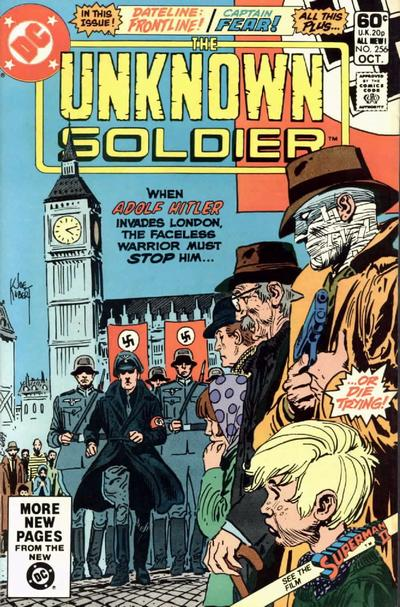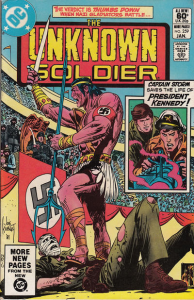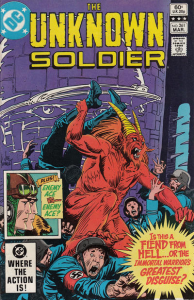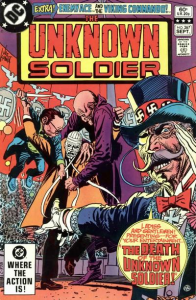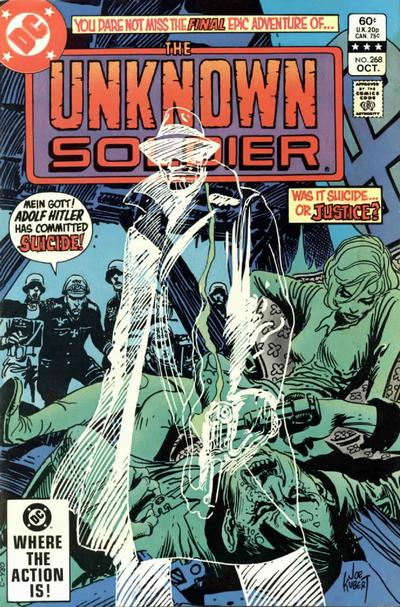This is the final installment in my overview of Bob Haney’s neglected run on The Unknown Soldier, which ended with a bang.
By 1980, this World War II-set comic had turned into a fairly mechanic, well-oiled enterprise. Haney churned out scripts with his usual quota of high-octane thrills – mostly standalone tales, yet with the occasional cliffhanger ending and a few recurring characters. The art chores were secured by Dick Ayers, a veteran workhorse in the industry (not to mention a WWII veteran himself). Ayers’ vast portfolio already included a ten-year stint as the primary artist on Sgt. Fury and His Howling Commandos, as well as loads of other war comics at both Marvel and DC, so he was comfortable briskly knocking out WWII adventures that, even when not at their most inspired, were never less than serviceable, especially given Gerry Talaoc’s crisp inks. Starting with issue #237 (cover-dated March 1980), colorist Bob LeRose gradually took over from Jerry Serpe – a change that wasn’t too noticeable at first, although LeRose did eventually introduce tighter, more subdued colors, which conjured up a grittier atmosphere. Len Wein became editor in #239 and seemed satisfied with The Unknown Soldier’s direction as a solid genre series.
The issues from this era delivered what can be catalogued as relatively straight spy tales, with the possible exception of that wacky story in which the Unknown Soldier disguised himself as a proto-Pied Piper in order to lure away German children who were being used as human shields (explicitly taking advantage of the fact that they had been indoctrinated by the Hitler Youth to follow orders without questions). Even Haney’s colorful prose could be considered a part of the comic’s general throwback vibe…
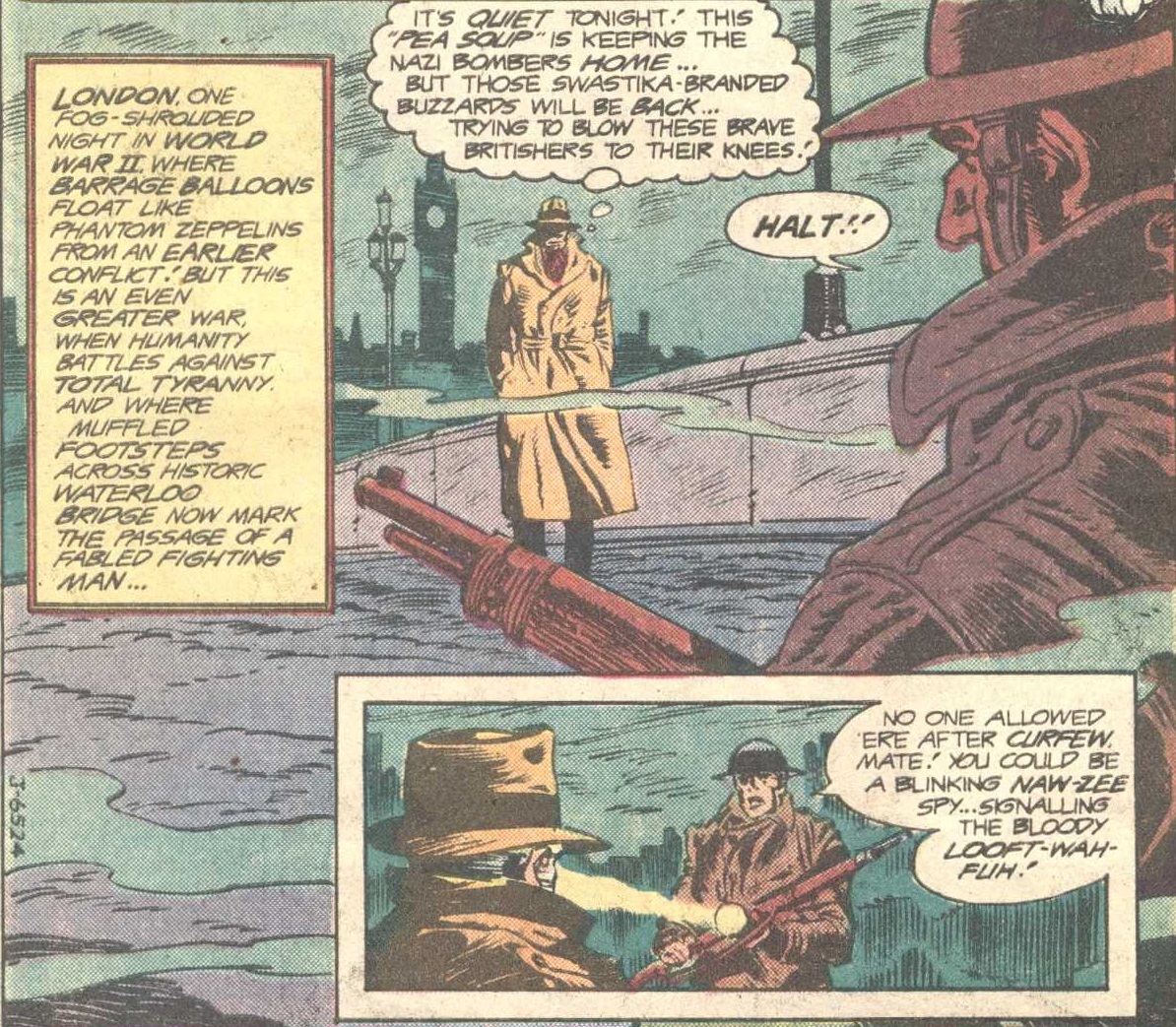 The Unknown Soldier #241
The Unknown Soldier #241
By ‘throwback vibe’ I mean that the series, for better or worse, had grown highly disconnected from the present, settling for reliving the moral universe of World War II (albeit in its more liberal version) almost as if it had been penned during that period. Naturally, a case can be made that the very act of depicting moral certitude in the turn towards the Reaganite 1980s ultimately adds up to an implicit endorsement of the righteousness of the United States’ interventionism abroad… Still, even when the Unknown Soldier went to the USSR, in ‘Red Flows the Don!’ (#242), instead of a Cold War-era propaganda-informed caricature, you got a somber take on the brutality of the Eastern Front and a recognition of the Russian partisans’ spirit of sacrifice.
(That said, if you want a thoughtful, gut-wrenching, and more historically realistic take on the Russian Front, go grab yourself a copy of Garth Ennis’ and Steve Epting’s graphic novel about Soviet women snipers, Sara, which looks absolutely stunning, not least because of Elizabeth Breitweiser’s coloring. In turn, if you’d like an intricate WWII spy thriller featuring communists, only with much more sex and swearing, have a go at Howard Chaykin’s Blackhawk!)
As I’ve mentioned before, Bob Haney’s Unknown Soldier was not a conflicted individual. For the most part, he was a fully committed agent who didn’t hesitate before killing traitors in cold blood or, as seen in a later issue, making nonchalant statements like this one:
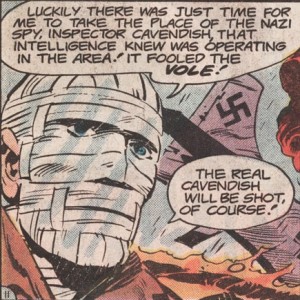 The Unknown Soldier #257
The Unknown Soldier #257
(To be fair, in one of his final stories, at least the Unknown Soldier grudgingly lets a group of exhausted US sailors flee into neutral Sweden, after one of them poignantly explains to him: ‘Not every fighting man is like you…! Not everyone can go on forever!’)
The whole premise of a committed, ultra-efficient secret agent gave the comic a discernable James Bond flavor, although without the campier aspects. There was even a (much less sexualized) version of Miss Moneypenny:
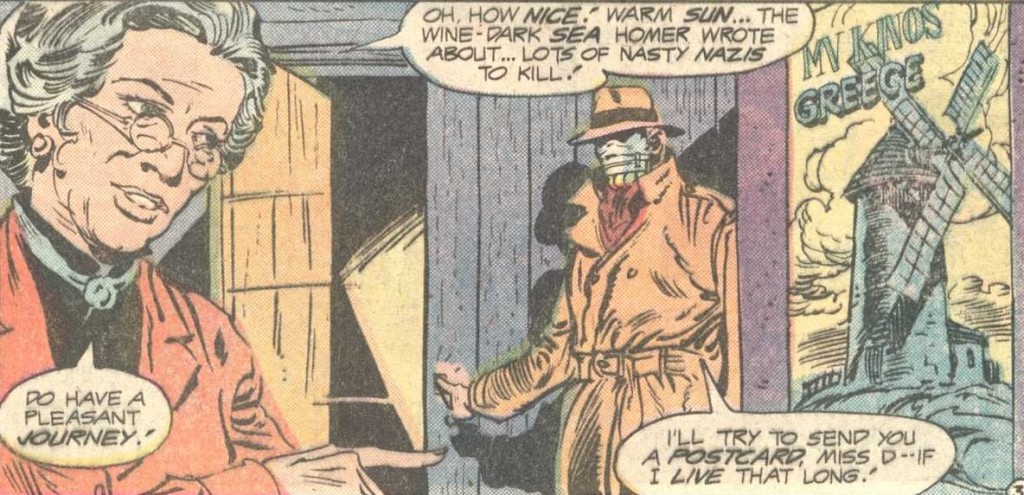 The Unknown Soldier #241
The Unknown Soldier #241
(This panel also works as a smooth bit of foreshadowing, as those windmills will eventually play a key role in the story, which is actually a pretty neat spy thriller…)
Not that anyone could accuse the series of lacking a specific identity. For one thing, Bob Haney stuck to the ridiculous gimmick that the Unknown Soldier wore incredibly perfect masks *over* his bandages. Haney also toyed with the fact that anyone could wear bandages and pass themselves off as the Unknown Soldier – if the hero’s facelessness made him a master of disguise, it also made it easy for his enemies to disguise themselves as him! In fact, almost everybody turned out to be able to seamlessly disguise themselves whenever it proved convenient to the plot… The growing number of Scooby-esque unmaskings made readers increasingly unsure about whom to trust.
Moreover, in a two-parter running in issues #248-249, Haney reworked the protagonist’s origin, tweaking Joe Kubert’s initial version only to then reveal it as just a cover story and then replace it with an update (which combined the original with the retroactive introduction of the more recent supporting cast), adding to the overall uncertain feel of artificial layers wrapped around more layers.
That two-parter also marked a shift into more superhero-y territory. Having pushed grimness to the brink in ‘Season in Hell!’ (#247), set in the Warsaw ghetto, Bob Haney injected the series with a renewed sense of daring buoyancy and spectacle. In a typical move of mainstream comics, issue #250 was a blockbuster saga pitting the Unknown Soldier against DC’s other major WWII characters (the ones featured in DC Goes to War), including Sgt. Rock, Mlle. Marie, the Losers, and the Haunted Tank. It was a fun reminder that, despite the absence of superheroes and similar characters, the comic was firmly set in the DCU’s World War II (a fact that, years later, led to a wonderful homage to this run, in Rick Veitch’s Swamp Thing #82).
The next issue is even wilder, as it piles up so many plot twists that it feels almost like a parody of the series’ formula… It involves the Unknow Soldier recruiting an abbot to help him make contact with his (the abbot’s) brother, who is an important leader of the German underground resistance. This is what happens when they finally meet (the Unknown Soldier is the mustachioed guy in the checkered coat):
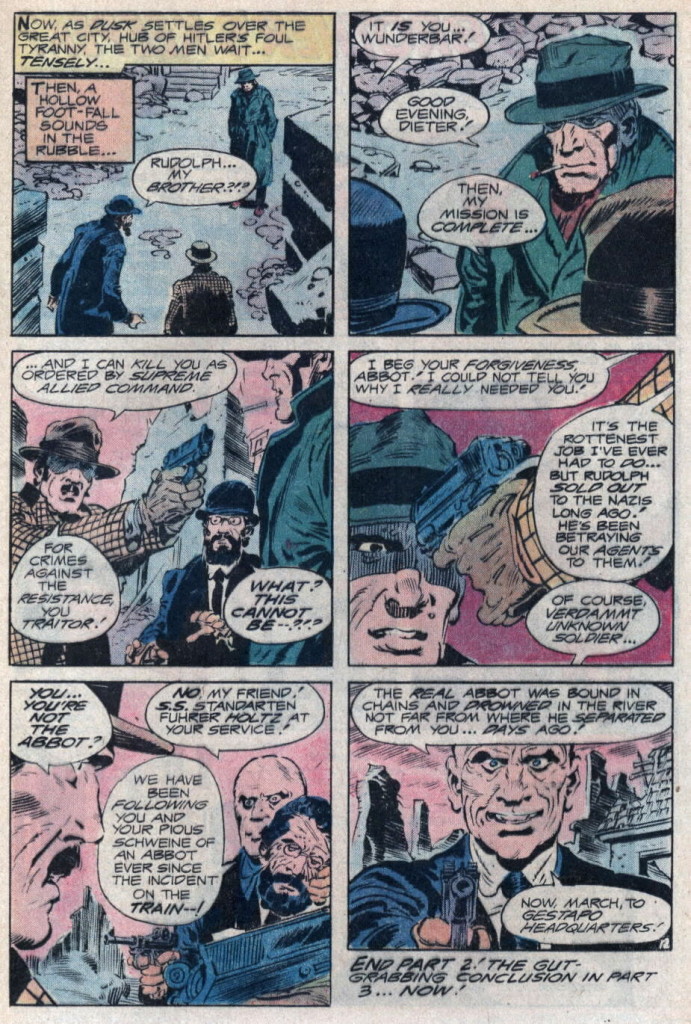 The Unknown Soldier #251
The Unknown Soldier #251
You’d think things would be allowed to settle for a bit after these two sudden, successive switcheroos, but you’d be wrong.
The pace is so relentless that in the very next page we get this:
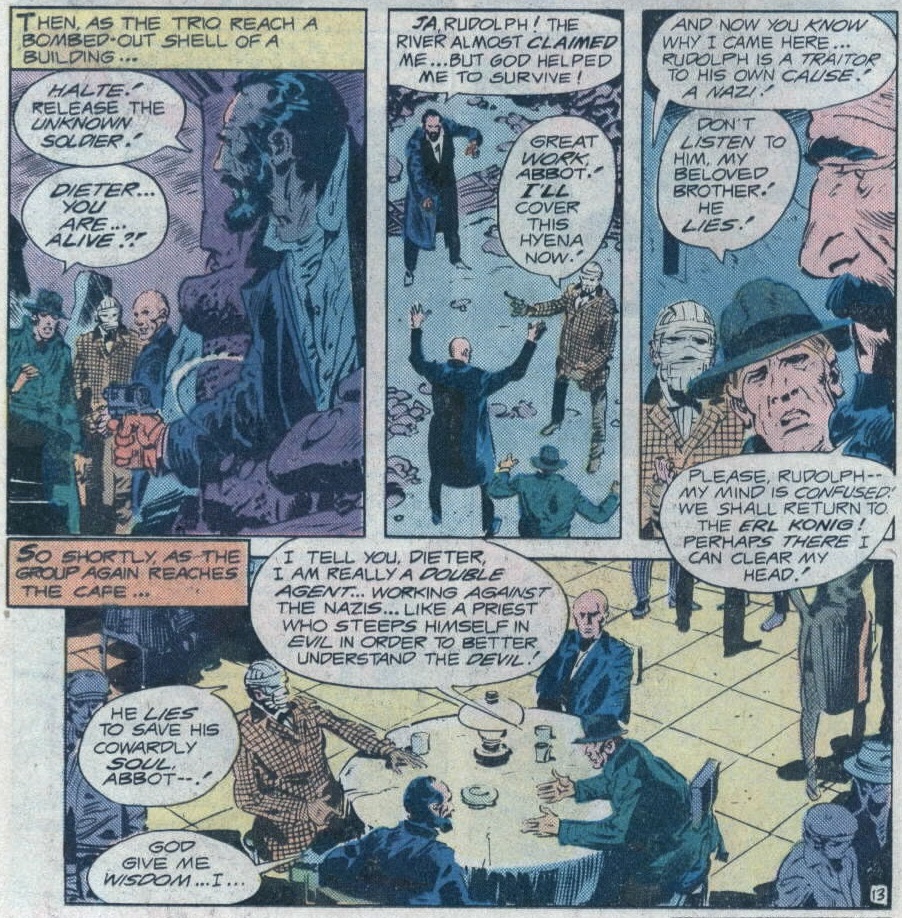 The Unknown Soldier #251
The Unknown Soldier #251
By then then, all bets were off. One of the Unknown Soldier’s missions in this latter stage involved tackling the fact that the moon was driving pilots insane. In another one, he fought Nazi circus magicians among the mystical atmosphere of Stonehenge. And, of course, there was the issue where our hero and his lover found themselves possessed by a sorcerous version of the Beauty and the Beast!
Sure, not all of them were like this. You also got a clever whodunit set on the North-African front (complete with a major tank battle) and one arc inspired by George Seaton’s underrated spy movie 36 Hours. Yet every time you felt the comic had returned to safer ground, the next issue would burn the rulebook all over again!
I don’t know where this final burst into strange fantasy came from. Perhaps it was the fact that Mike W. Barr joined the editorial team. Or perhaps at least part of the explanation may involve the hype surrounding what came to be the next age-defining historical adventure blockbuster: Raiders of the Lost Ark.
Indeed, if the David Michelinie-penned Unknown Soldier sometimes captured the tone of Italian ‘macaroni combat’ movies, Bob Haney’s late run seemed increasingly in tune with the spirit of Indiana Jones. When his hero went on a mission in China, rather than finding himself immersed in cloak & dagger intrigue, the Unknown Soldier now got involved in an ancient conflict between local pirates and warlords who didn’t give a damn about his mission…
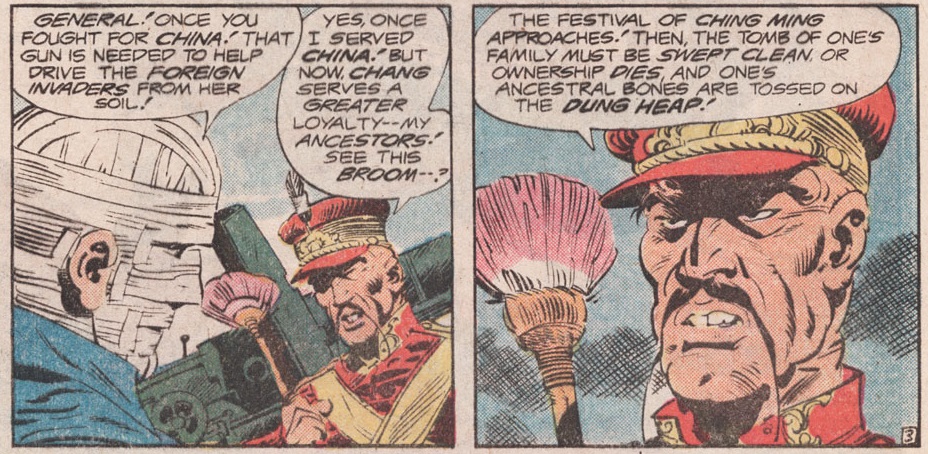
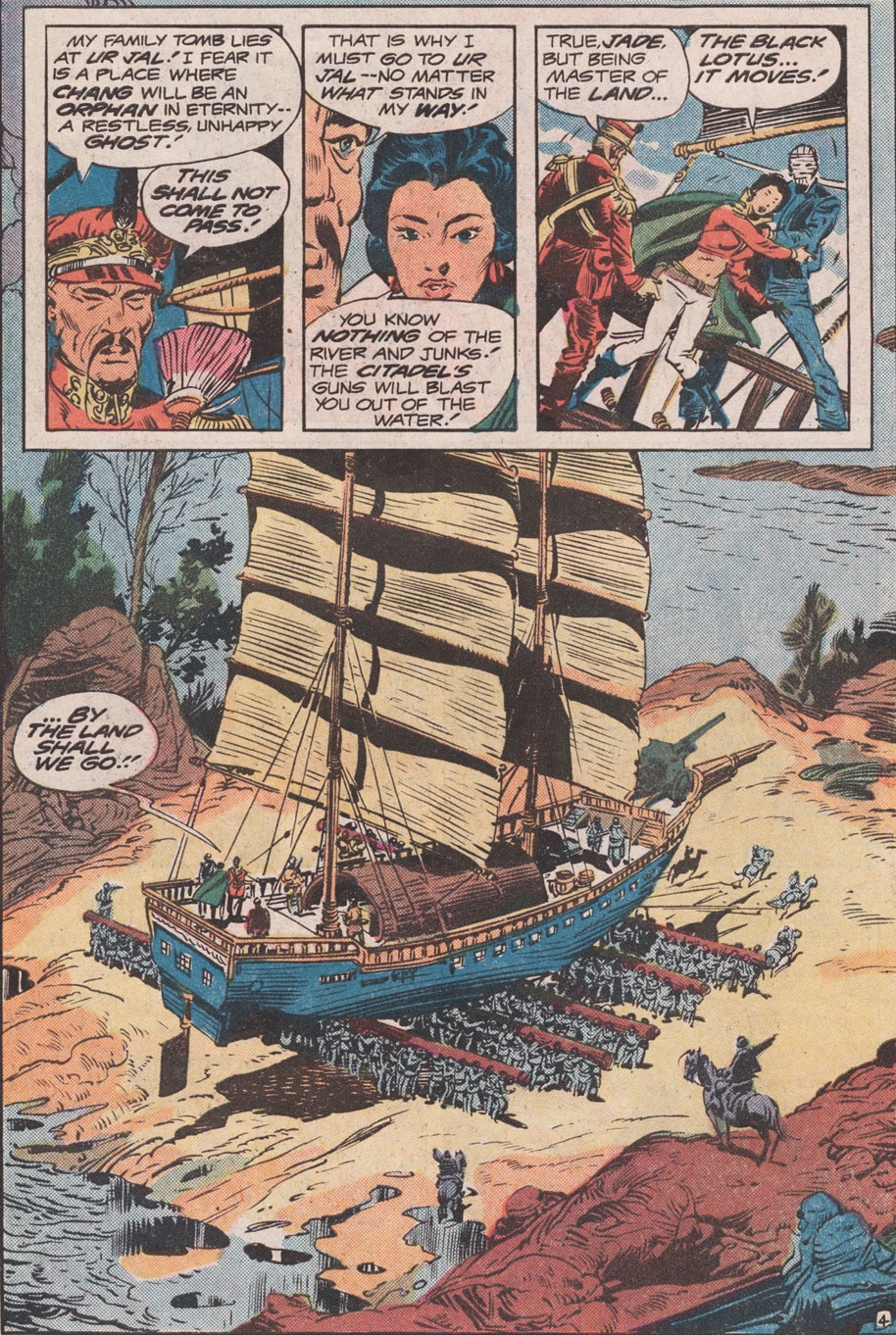 The Unknown Soldier #255
The Unknown Soldier #255
I know the timing isn’t absolutely right and the tonal similarities probably have more to do with shared sources of inspiration than with direct influence. However, when you look at the splash page below, with the torn papyrus-like caption, the Nazi villain’s look, the borrowed religious imagery, and the set piece’s recognizably pulpy action (complete with a monk pointing a crossbow in the background), you’ve got to wonder… That comic came out on 24 September 1981 (according to Mike’s Amazing World), three months after the premiere of Raiders of the Lost Ark, so the creators didn’t necessarily watch the film before the issue was practically ready, but maybe some of the movie’s earlier promotional campaign had an impact, even if on a subconscious level…
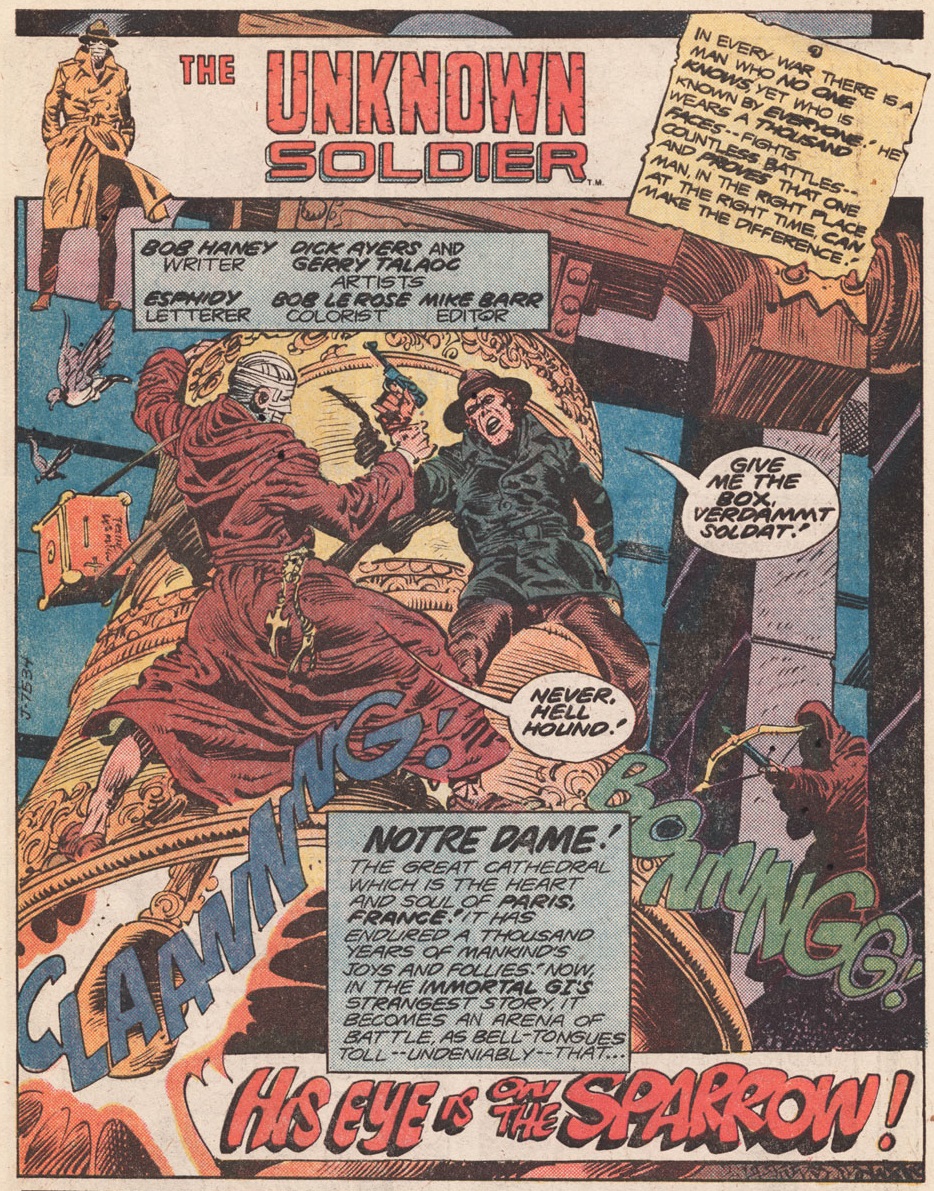 The Unknown Soldier #258
The Unknown Soldier #258
And where did all this lead up to? In retrospect, it should come as little surprise that the epic final issue, #268, which came out in July 1982 (yet was cover-dated October), involved a desperate Adolf Hitler preparing an invasion of biologically weaponized blood-sucking octopi, a denouement that was then topped with a revisionist twist worthy of Quentin Tarantino (if not quite as radical as the one in Inglourious Basterds). Pulling out all the stops, the issue even poignantly killed off much of the recurring cast, including the hero himself…
Yes, earlier that year, the (commitedly anti-war) DC Comics Presents #42, written by Paul Levitz, had already established that the Unknown Soldier secretly survived WWII, which took some of the edge out of this twist. To be fair, though, Haney and Ayers did leave that door open anyway, through an ambiguous final image where a soldier’s gesture could be taken as a reference to the hero’s habit of scratching at the base of his facial disguises.
All in all, this is one of the all-time greatest finales to a comic book run.

